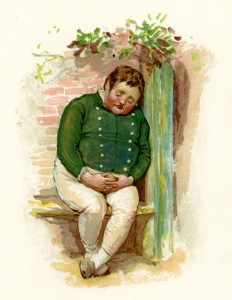Sleep apnea, also called obstructive sleep apnea or OSA, is not a new disorder by any means. While it might seem like it’s becoming more prominent due to the increase in obesity over the past few decades, symptoms of sleep apnea-like disorders have been observed for centuries. Luckily, technology and doctors’ understanding of the causes of sleep apnea have improved greatly, allowing for more comfortable, less invasive treatments that help sufferers improve their quality of sleep and quality of life.
Pickwickian Syndrome
While sleep apnea itself wasn’t named and officially designated as a disorder until the late twentieth century, records indicate that the symptoms were noticed and remarked upon nearly 2,000 years ago. In the nineteenth century, doctors began to lump sleep apnea symptoms together using the name “Pickwickian syndrome”. The name came from Charles Dickens’ The Pickwick Papers, in which an overweight character named Joe exhibited symptoms of what would later become known as sleep apnea.
But those individuals investigating Pickwickian syndrome concentrated narrowly on body fat as a key part of developing the condition. In other words, obesity was a red herring. While being overweight can certainly contribute to sleep apnea, later studies confirmed that obesity was not the only reason for developing sleep apnea. Although extra weight around the neck can increase the pressure on the throat tissues when you lie down, thus narrowing the airway, it is not the only possible cause of airway obstruction.
Other causes of sleep apnea include:
- Overly relaxed throat and neck muscles due to eating or drinking too closely to bedtime
- Any sort of nasal or pharyngeal/laryngeal blockage, including nasal polyps and plain old nasal congestion
- Flabby throat and mouth structures, such as a large uvula (the flap of tissue you see hanging down in the back of the throat) or soft floppy palate
Ramping Up Research on the Causes of Sleep Apnea
The 1950s and 1960s saw an uptick in apnea research. New studies allowed researchers to finally see that the core problem in sleep apnea was that people were not breathing properly during sleep, rather than people developing a collection of symptoms that just seemed to happen together.
Research into the “whats”, “whys” and “hows” of sleep apnea really took off in the 1970s. Initially, researchers looked at sleep and breathing in dogs, using tracheotomies to treat the condition. Tracheotomies were also the treatment of choice for humans at that time. As outlandish as that sounds now, it was the only way researchers could figure out how to get air past any type of throat blockage.
In the late 1970s and early 1980s, researcher Colin Sullivan developed a customized mask that seemed to help dogs – and later humans – breathe during sleep. Airflow with positive pressure was delivered through the mask, creating an early form of continuous positive airway pressure, or CPAP. Results with the masks were so good – all five human subjects in an initial study were able to keep their airways open during sleep – that Sullivan wanted to make the treatment more widespread. People didn’t take to his solution immediately, but over the years, CPAP has become the go-to treatment for many sleep apnea sufferers.
Customized Treatment
Because the causes of sleep apnea can be so varied, treatment for patients has to fit the cause. In many cases, CPAP will be the way to go, but for others, surgery or additional treatments may better alleviate the problem.
If you have been suffering from sleep apnea, or you think you have the symptoms, visit our website to take a snore quiz that determines your level of risk for sleep apnea or take the Berlin Scale to determine if you are a candidate for sleep apnea treatment. You can also contact eos sleep to schedule an evaluation with one of our board-certified physicians who can diagnose your condition and get you started on the road to better sleep.
While sleep apnea may not be a new sleep disorder, fortunately there are many new treatment options that can effectively treat the underlying causes of your condition – several of which can be performed right in the office in as little as 30 minutes and without any downtime.

